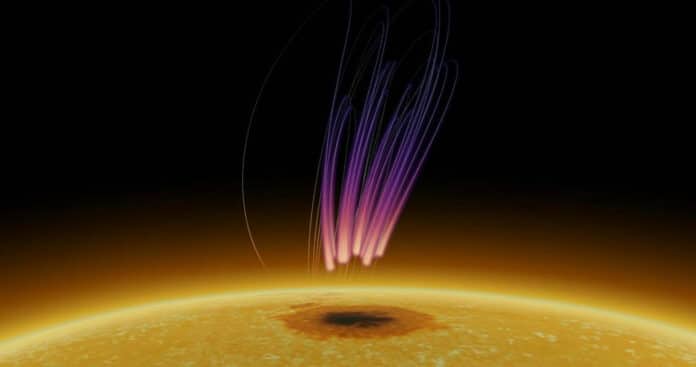Planetary magnetospheres, magnetically active low-mass stars, and brown dwarfs display intense radio bursts that are highly polarized. These bursts are believed to be caused by energetic electrons in the planetary polar region or the stars’ converging magnetic field, emitting electron cyclotron maser radiation.
In a new study, astronomers from the New Jersey Institute of Technology‘s Center for Solar-Terrestrial Research (NJIT-CSTR) report observations of long-lasting solar radio bursts above a Sunspot. Astronomers observed radio observations of an extraordinary aurora-like display 40,000 km above a sunspot.
The new radio emission resembles auroral radio emissions frequently observed in planetary magnetospheres.
The finding may shed light on the source of these powerful solar radio bursts and pave the way for research into related phenomena in far-off stars with massive starspots.
The study’s lead author and NJIT-CSTR scientist, Sijie Yu, said, “We’ve detected a peculiar type of long-lasting polarized radio bursts emanating from a sunspot, persisting for over a week. This is quite unlike the typical transient solar radio bursts, typically lasting minutes or hours. It’s an exciting discovery that has the potential to alter our comprehension of stellar magnetic processes.”
“The newly observed solar radio emissions, detected over a vast sunspot region temporarily forming where magnetic fields on the Sun’s surface are powerful, differ from previously known solar radio noise storms — both spectrally and temporally.”
“Our spatially, temporally, and spatially resolved analysis suggests that they are due to the electron-cyclotron maser (ECM) emission, involving energetic electrons trapped within converging magnetic field geometry. The sunspots‘ cooler and intensely magnetic areas provide a favorable environment for the ECM emission to occur, drawing parallels with the magnetic polar caps of planets and other stars and potentially providing a local solar analog to study these phenomena.”
As a direct result of the sunspot’s magnetic field being thousands of times stronger than Earth’s, these aurora emissions from sunspots occur at frequencies ranging from hundreds of thousands of kHz to around one million kHz, unlike those from Earth.
According to the observations, these radio bursts are also not always associated with solar flare timing. Instead, the ECM radio emission above the region appears to be powered by intermittent flare activity in neighboring active regions that pump energetic electrons into large-scale magnetic field loops anchored at the sunspot.
The “sunspot radio aurora” exhibits rotational modulation in time with the solar rotation, creating a “cosmic lighthouse effect,” reported Yu.
Yu said, “As the sunspot traverses the solar disk, it creates a rotating beam of radio light, similar to the modulated radio aurora we observe from rotating stars. As this sunspot radio aurora represents the first detection of its kind, our next step involves retrospective analysis. We aim to determine if some previously recorded solar bursts could be instances of this newly identified emission.”
Bin Chen, NJIT-CSTR associate professor of physics and a co-author, said, “This observation is among the clearest evidence of radio ECM emissions we have seen from the Sun. The characteristics resemble some of those observed on our planets and other distant stars, leading us to consider the possibility that this model could be applicable to other stars with starspots.”
The team says the latest insight, linking the behavior of our Sun and the magnetic activities of other stars, could have implications for astrophysicists to rethink their current models of stellar magnetic activity.
NJIT solar researcher Surajit Mondal said, “We’re beginning to piece together the puzzle of how energetic particles and magnetic fields interact in a system with the presence of long-lasting starspots, not just on our own Sun but also on stars far beyond our solar system.”
Dale Gary, NJIT-CSTR distinguished professor of physics, said, “By understanding these signals from our own Sun, we can better interpret the powerful emissions from the most common star type in the universe, M-dwarfs, which may reveal fundamental connections in astrophysical phenomena.”
Journal Reference:
- Yu, S., Chen, B., Sharma, R. et al. Detection of long-lasting aurora-like radio emission above a sunspot. Nat Astron (2023). DOI: 10.1038/s41550-023-02122-6
